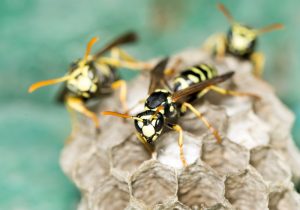 Florida is crawling insects that can not only bite, but sting as well. If you notice a nest of buzzing insects inside your attic or outside around your home, it’s important that you, your pets, and your family keep a safe distance while you determine what type of insect you’re dealing with. To keep your allergic loved ones out of harm’s way, follow this list to identify which stinging insect has invaded your property.
Florida is crawling insects that can not only bite, but sting as well. If you notice a nest of buzzing insects inside your attic or outside around your home, it’s important that you, your pets, and your family keep a safe distance while you determine what type of insect you’re dealing with. To keep your allergic loved ones out of harm’s way, follow this list to identify which stinging insect has invaded your property.
Bees
Yellow and black in appearance, most species of bee are naturally gentle and only sting if threatened.
- Honeybees – small and shiny, honeybees nest in porous hive colonies like honeycombs. Because of their inability to remove their barbed stingers, honey bees die after stinging.
- Bumblebees – plump, fuzzy and identifiable by their loud buzzing sounds, bumble bees nest in clumps of pollen, ground holes, hollow trees, or along the walls of buildings.
- Carpenter Bees – fuzzy-coated with a shiny abdomen, carpenter bees bore into decaying wood to make galleries for their young. While the male carpenter bees do not have stingers, they can be aggressive and territorial. Female carpenter bees can sting if provoked but are mostly docile.
Hornets
Shorter than an inch in length, hornet species such as the bald-faced hornet are black in appearance with a white face. The extremely aggressive winged-insects are able and willing to supply a painful sting if they feel their nest is threatened. Made out of a mixture of saliva and wood that resembles paper mâché, their large circular nests often hang in trees and attics, or on the sides, eaves, door frames, and windowsills of residential homes. Bald-faced hornets should be approached with caution as a single nest can contain several thousand hornets.
Wasps
Like hornets, wasps have smooth stingers with no barbs and therefore can repeatedly sting if provoked. Common species of wasp include:
- Mud daubers – typically black in color, these solitary wasps can inject venom through their sting if disturbed. They are known to build mud nests under eaves and porches and in sheds, barns, and garages.
- Yellowjackets – thin and slender-bodied with black and yellow markings, yellowjackets are similar in size, appearance, and sting to bees. These wasps tend to build paper-like nests inside logs or in the ground; however, their nests have also been found attached to structures like houses, bushes, and sheds. Although they are fiercely aggressive, yellowjackets are slow to sting unless their nests are in danger.
Contact Critter Control® of Orlando
If you find an active nest on your property, do not attempt to remove it on your own. Instead, contact professional pest control specialists who are experienced in handling stinging insects. At Critter Control® of Orlando, our licensed technicians will conduct a thorough inspection to identify your threat and determine the most effective way to safely relocate or remove the pests from your property. To schedule a consultation or learn more about our insect removal services, call us today at 407-295-7194.





